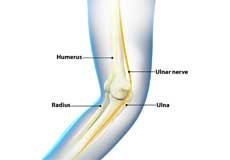
The ulnar nerve is one of the 3 main nerves in the arm that travels down from the neck toward the hand. The ulnar nerve supplies senssation to part of the wrist and palm, as well as the little finger and half of the ring finger. The ulnar nerve helps in controlling many of the hand muscles which carry out fine movements as well as some bigger forearm muscles which help in making a strong grip.
The ulnar nerve can be constricted in many places,which results in nerve entrapment. The pressure on the nerve can cause pain and numbness in various parts of the forwarm, wrist and hand. Compression of the nerve occurs most commonly against the medial epicondyle, and this is called cubital tunnel syndrome. Ulnar nerve transposition is a surgical procedure performed to transpose or move the ulnar nerve to an appropriate position in front of the medial epicondyle.
Indications for Ulnar Nerve Transposition
Ulnar nerve decompression is indicated to relieve the pressure placed on the compressed ulnar nerve. If the ulnar nerve is unstable or subluxating, or if it is under excessive tension when the elbow is flexed, transposition of the nerve may be necessary. Conditions that may require ulnar nerve transposition include:
- Compression of the ulnar nerve caused due to injury or excessive pressure placed on the elbow.
- Activity or position related pressure on the ulnar nerve
- Failure of conservative therapy measures.
- Drawing back (clawing) of the fourth and fifth digits of your hand.
- A progressive loss of sensibility of movement in the hand
Preparation before Surgery
Before undergoing ulnar nerve transposition surgery, your doctor will carry out a complete clinical examination and may order blood tests and other diagnostic studies. At the time of surgery, the affected area from the shoulder to the fingers will be cleaned and prepared for the surgery, and a tourniquet (device to stop blood flow) may be applied to the arm to minimize bleeding.
How is the Procedure Performed?
Ulnar nerve transposition is performed under general or regional anesthesia.
Your surgeon will make an incision on the inside of the elbow around the medial epicondyle and locate the ulnar nerve. The ulnar nerve will be fully decompressed by relieving all sites of compression along the nerve as it courses around the elbow.
Transposition: Your surgeon then carefully moves the ulnar nerve from under the medial epicondyle and positions it in front of it (anterior transposition). The nerve can be placed on top of the muscle, under the skin and fat (subcutaneous transposition), under the muscle (submuscular transposition) or within the muscle (intermuscular transposition). The incision will then be sutured. The anterior transposition helps prevents nerve entrapment at the bony ridge and stretching of the nerve when the elbow is bent.
Post-operative Care
Following the procedure, the elbow will be wrapped with a bulky dressing. Occasionally, a splint will be applied to immobilize the elbow and protect the area. You will be given instructions for rehabilitation after surgery to work on regaining flexibility and strength. You can resume regular activities after consulting with your doctor.
Risks and Complications
As with any surgical procedure, ulnar nerve transposition involves certain risks and complications. Some of the complications that may occur include:
- Nerve injury
- Failure to completely decompress the ulnar nerve
- Infection
- Thrombophlebitis (inflammation of veins)
Related Topics
- Open Elbow Surgery
- Distal Biceps Repair
- ORIF of the Humerus Fractures
- Radial Head ORIF and Replacement
- Common Extensor Tendon Origin Repair
- Total Elbow Replacement
- Elbow Arthroscopy
- ORIF of the Coronoid Fractures
- Elbow Ligament Reconstruction
- Elbow Tendon and Ligament Repair
- UCL Reconstruction (Tommy John Surgery)
- Tennis Elbow Surgery
- Ulnar Nerve Release
- Ulnar Nerve Transposition
- ORIF of the Distal Humerus Fractures
- ORIF of the Olecranon Fractures
- Ulnar Collateral Ligament (UCL) Repair with Internal Brace





